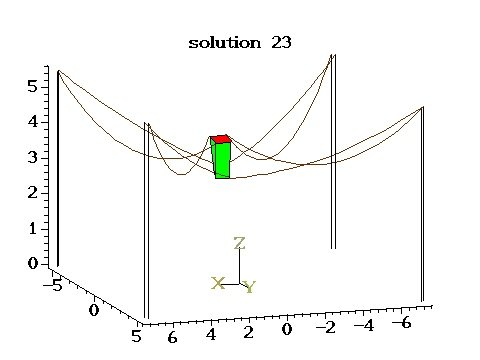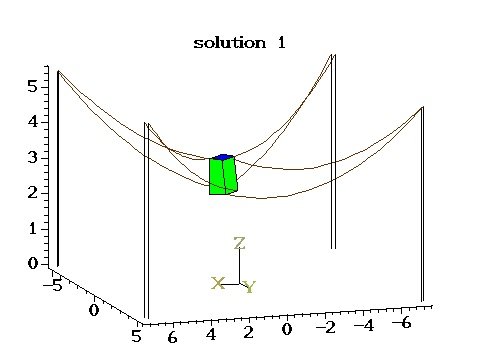Section:
New Results
Robotics
Analysis of Cable-driven parallel robots
Participants :
Alain Coulbois, Artem Melnyk, Jean-Pierre Merlet [correspondant] , Yves Papegay.
We have continued the analysis of
suspended CDPRs for control and design
purposes[12]. For control it is essential to determine the current pose of
the robot for given cable lengths (forward kinematics, FK) and to be
able to calculate the cable lengths for a given pose of the platform
(inverse kinematics, IK). If the cables are supposed to be
non-deformable the IK problem is trivial and has a single solution but
the FK is complex,
admits several solutions and raises several issues. We have shown in
the past that to get all FK solutions for a CDPR with cables we
have to consider not only the case where all cables are under tension
but also have to solve the FK for all combinations of cables under
tension with 1 to cables.
Surprisingly the
FK is more difficult if the CDPR has less than 6 cables under
tension. Our team, in collaboration with M. Carricato of Bologna
University, is the first to have
designed a solving algorithm that allow to compute in a guaranteed
manner all FK solutions while a theoretical approach has allowed us to
provide a bound for the maximal number of solutions according to the
number of cables under tension (respectively 24, 156, 216, 140 and 40
for 2, 3, 4, 5, 6 cables).
Even more complex kinematic problems are involved if we assume that
the cable are catenary-like, which is valid for large dimension robot,
and involves inverse hyperbolic functions and square root,
prohibiting to use algebraic geometry tools for estimating the maximal
number of solutions and for the solving. In that case both the IK and
FK may have multiple solutions and we have exhibited last year
interval analysis-based solving algorithms for the IK and FK based on
our interval analysis library ALIAS , that is the only existing
algorithm for managing such complex cables.
However such algorithm has the
drawback, beside being computer intensive, to provide only
solution(s) within a given search space for the
unknowns. In our IK and FK problems two unknowns for each cable are
the horizontal and vertical components of the force exerted by the
cables on the platform. In our case we have only the constraint
and lower than half the mass of the cable but have no
upper bound for and lower bound for . We may choose
arbitrary large values for these bounds at the expense of an
exponentially increasing computation time. As for the IK, beside , the length of the cable at rest is an unknown with
but no known upper bound. This year we have both improved the interval
analysis algorithms but have also explored an original continuation
scheme that be used both for the IK and FK whatever is the cable
model. The idea is to assume that the cable model includes a set
of physical parameters which describe the elastic and
deformation behavior of the cable material. We assume that their are
limit values for these parameters such that the cable
behave like a
non-deformable, non-elastic cable while the real cable parameter is
. For example for catenary cables
elasticity is defined by the Young modulus of the cable material
while the cable deformations is conditioned by its linear density
. If goes to infinity and to 0, then the cable is
non-deformable, non-elastic. Now let us assume that we have a robot
state for which the IK or FK are satisfied with the parameters . Assume that we modify by a sufficient small amount
toward so that the Newton scheme allow us to
determine the new robot state for . Proceeding
iteratively along this way will lead us to a robot state that must be
very close to one obtained for non deformable, non elastic cables. Now
we may revert the process: starting from all the IK or FK solutions
obtained for non deformable cables (corresponding to ) we use Newton to compute a new robot state with
closer to and doing that iteratively will lead to the
solution(s) for ). We have also shown that a
safe value of (ie. one that guarantee to obtain continuous
solution without jump) may be calculated at each step by using the
Kantorovitch theorem.
We have implemented this
principle for both the IK and FK problems (for 6 cables for the IK)
and have found new IK and FK
solutions which not been found previously because they were outside
the search space of the interval analysis algorithms. A side benefit
of this principle is that it has allowed us to be the first to provide
an upper bound on the maximal number of solutions (63 for the IK of a robot
with 6 cables, 33383 for the FK of a robot with 8 cables) whatever is
the cable model. These new algorithms are much faster than the
previous one (around one minute for the IK and 10 mn for the FK
instead of several hours). However they raise a theoretical issue as
the continuation scheme may lead to a solution that is close to be
singular in which case the scheme cannot work. Understanding the
singularity of the kinematics of CDPR is therefore a major
problem. For the time being we mix the continuation scheme with the
interval one that is basically used to solve the kinematic problem
when the continuation scheme detect a singularity. As a test example
we have considered a difficult CDPR with 8 cables and have shown a case
with up to 41 solutions for the FK [10],[14],[11]. Figure 2 shows two of
these solutions.
Figure
2. Two poses that are solutions of the forward kinematics, the
left one being unstable while the right one is stable.
|
|
We have also investigated the calculation of cross-section of the
workspace of CDPR [13]. We have shown that the border of this workspace for
non deformable of purely elastic cables may
be calculated rigorously by using an algorithm mixing a theoretical
approach and numerical calculation. For catenary cables we have
proposed a method that calculates a set of boxes that are guaranteed
to lie in the workspace, getting smaller and smaller as soon as they
are close to the border. Unfortunately this algorithm is highly
computer intensive.
Cable-Driven Parallel Robots for additive manufacturing in
architecture
Participant :
Yves Papegay.
Easy to deploy and to reconfigure, dynamically efficient in large workspaces
even with payloads, cable-driven parallel robots are very attractive
for solving
displacement and positioning problems in architectural building at scale 1 and
seems to be a good alternative to crane and industrial manipulators in
the area of additive manufacturing.
Based on the proof of concept developed during the previous
collaboration with CNAM and Ecole Nationale Supérieure d'Architecture
Paris-Malaquais, the design of a new large scale CDPR for additive
manufacturing of building based on ultra-high performance concrete has
started under our supervision.
A new partnership with the the XtreeE start-up company aiming at
developing a real size industrial 3D-printer of concrete has been
established.




